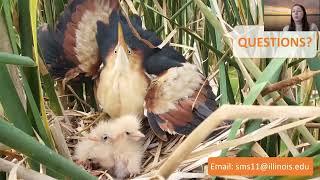
The Effects of Water Drawdowns on Marsh Bird Nest Survival at Emiquon Preserve, IL
Full Title: The Effects of Water Drawdowns on Marsh Bird Nest Survival at Emiquon Preserve, IL
Authors: Thomas J. Benson, Auriel M. V. Fournier, and Joshua M. Osborn
Abstract: Marsh birds are birds that are habituated to changing hydric conditions and are often associated with complex vegetated habitat interspersed with open water that provides protection from predators and a space to forage. Unfortunately, marsh bird populations are experiencing declines worldwide, and these are believed to be driven by wetland loss and degradation, something that is characteristic to the heavily altered landscape of Illinois. Illinois originally had an estimated 8.9 million acres of poorly drained hydric soil, however by the 1980s, 90% of this wetland acreage was lost due to drainage for agricultural expansion and urbanization. Proper management of the remaining wetland habitat is believed to be the solution for mitigating further marsh bird losses. The Nature Conservancy at Emiquon Preserve manages their wetland habitat through a controlled drawdown of water from June to August after marsh birds have initiated nesting. However, knowledge on the effects of water-level manipulation for nesting marsh birds is limited, and we are particularly interested in learning more about the effects water drawdowns have on nest success and predator access to nests. In 2020 and 2021, Emiquon Preserve underwent an intense (4.5 ft) and a minimal (1.5 ft) drawdown, respectively. In both years we searched suitable habitats (hemi-marsh, dense emergent) and located marsh bird nests (Least Bittern, Common Gallinule, Black-crowned Night-Heron, American Coot) (n=158) at varying water depths and distances from the shore. We set up continuously recording cameras at a subset of nests (n=80) to record predators at the nests and we revisited the nests throughout the season to document their fate. We found that nests in shallow water and following an intense drawdown faced an increased risk of predation by mammals. These results suggest that high intensity and early season drawdowns for wetland management may be exacerbating predation risk at marsh bird nests.
This presentation was part of the 17th Emiquon Science Symposium which took place March 30, 2022 as a zoom webinar.
Authors: Thomas J. Benson, Auriel M. V. Fournier, and Joshua M. Osborn
Abstract: Marsh birds are birds that are habituated to changing hydric conditions and are often associated with complex vegetated habitat interspersed with open water that provides protection from predators and a space to forage. Unfortunately, marsh bird populations are experiencing declines worldwide, and these are believed to be driven by wetland loss and degradation, something that is characteristic to the heavily altered landscape of Illinois. Illinois originally had an estimated 8.9 million acres of poorly drained hydric soil, however by the 1980s, 90% of this wetland acreage was lost due to drainage for agricultural expansion and urbanization. Proper management of the remaining wetland habitat is believed to be the solution for mitigating further marsh bird losses. The Nature Conservancy at Emiquon Preserve manages their wetland habitat through a controlled drawdown of water from June to August after marsh birds have initiated nesting. However, knowledge on the effects of water-level manipulation for nesting marsh birds is limited, and we are particularly interested in learning more about the effects water drawdowns have on nest success and predator access to nests. In 2020 and 2021, Emiquon Preserve underwent an intense (4.5 ft) and a minimal (1.5 ft) drawdown, respectively. In both years we searched suitable habitats (hemi-marsh, dense emergent) and located marsh bird nests (Least Bittern, Common Gallinule, Black-crowned Night-Heron, American Coot) (n=158) at varying water depths and distances from the shore. We set up continuously recording cameras at a subset of nests (n=80) to record predators at the nests and we revisited the nests throughout the season to document their fate. We found that nests in shallow water and following an intense drawdown faced an increased risk of predation by mammals. These results suggest that high intensity and early season drawdowns for wetland management may be exacerbating predation risk at marsh bird nests.
This presentation was part of the 17th Emiquon Science Symposium which took place March 30, 2022 as a zoom webinar.
Комментарии:

















